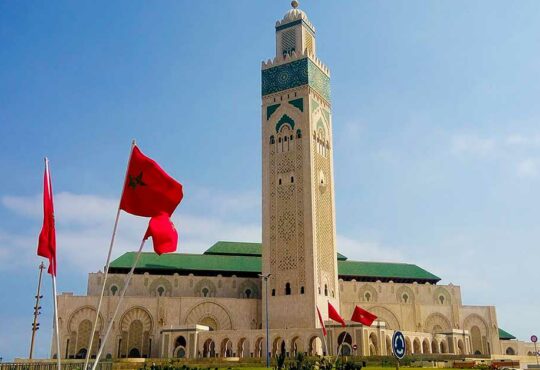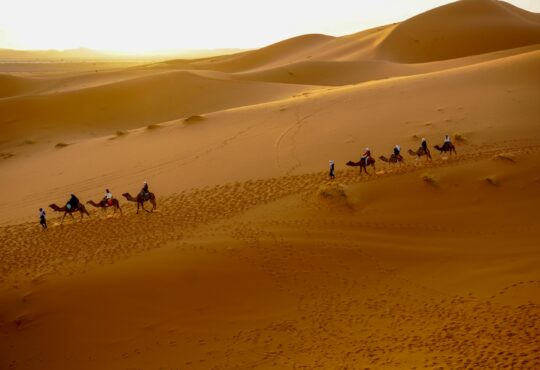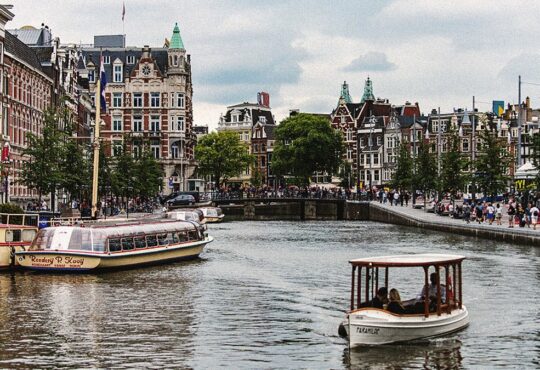668
There is more to Saudi Arabia than the vast golden dunes of sand. Saudi Arabia is home to some of the most historical cities, lush places, bustling souqs, and extravagant skyscrapers.
A few years back Saudi Arabia wasn’t open to international tourism. Fortunately, in 2019 the country has launched a tourist visa allowing international travelers from America, and Europe to experience the new world that’s called Saudi Arabia.
If you are interested in experiencing this beautiful country with untouched and unexplored wonders, this blog post features the most iconic landmarks in the country that you should definitely visit.
Read more:
Al Qarah Mountain
Al Qarah Mountain
Visiting Al Qarah mountain in Saudi Arabia is one of the must-do things in Saudi Arabia. Al Qarah mountain is just a 25 minutes drive from Al Hofuf city toward Al Ahsa national park. The mountain is about 75 meters (250 feet) tall and it will be easily spotted long before you arrive at Al Qarah village.
In addition to exploring the mushroom-shaped caves and narrow canyons, you can climb the mountain to enjoy the 360 degrees panoramic view of Al Ahsa city including its palm trees Oasis.
The Oasis, also called Al Ahsa Oasis, is considered the largest Oasis in the world and it became a world heritage in 2018. The Oasis includes more than 2,5 million palm trees producing different types of dates.
Al Wahbah Crater
Al Wahbah Crater
Formed by a volcanic eruption, Al Wahbah Crater is a natural wonder to visit in Saudi Arabia. Located about 250 km (160 miles) from Al Taif city, the crater is 780 m (2,560 ft) deep and 6.90 km (4.29 mi) in diameter.
Before scientists could prove the cause of Al Wahbah crater, it was thought that the crater was formed by a meteorite.
Adventurous people could try and climb down the crater. It could take about an hour or so. However, climbing back is the tricky part as the surfaces are slippery.
The Edge of the World
The Edge of the World
The edge of the world or what’s known for its real name“Jebel Fihrayn” is a popular destination in Saudi Arabia.
Rising dramatically from the desert, the massive rocky cliffs are formed by tectonic movements of the Arabian plate toward the northeast caused by the spread of the Red Sea rift 1,000 kilometers to the west of the Tuwaiq escarpment.
When standing on top of the escarpment, you get an uninterrupted view of the horizon. The edge of the world is a dramatic geological wonder that one must visit. It’s about one and a half hours drive from Riyadh.
There are a few rocky road options to get there but one must be prepared. A good SUV or a 4X4 is highly recommended. Also, consider good climbing shoes because you will do a lot of that.
Hegra (Mada’in Salih)
Mada’in Saleh
Mada’in Saleh also known as al-Hijr, or Hegra are a group of magnificent tombs carved into the golden Quweira sandstone outcrops by the Nabataean people. Based on the tomb inscriptions, Hegra thrived between 1 BCE and 74 CE.
The special feature of tombs in the town of Hegra is the delicate details on the entrance portals that remind us of Petra in Jordan, the capital city of the Nabataeans.
The city of Hegra is formed by multiple wonderfully carved tombs that unfold the Nabateans’ history and culture. Mada’in Saleh has been a UNESCO World Heritage Site since 2008.
If you happen to be in Saudi Arabia, make sure to visit Mada’in Saleh.
Read Also: Hot Air Balloon Festival in Hegra
The Valley of Moses (Tayyib Al-Ism)
Tayyib Al Ism
Tayeb Al-Ism is one of the magical natural wonders that visitors must include in their Saudi Arabia itinerary. This incredible natural granite massif is located on the Gulf of Aqaba, just 15 kilometers north of the coastal town of Maqna.
Tayyib Al-Ism is also called the valley of Moses because it is believed that when Moses brought the people out of Egypt through the Red Sea they reached the land of Madyan at Tayeb Al-Ism. Also, Madyan is the land where Moses spent ten years in voluntary exile after fleeing from Egypt.
One of the unique features of the canyon of Tayyib Al-Ism is that it consists of mountains as well as the sea with the beachside road.
The Red Sea near Maqna is a popular scuba diving site because of its pristine coral reefs. People who want to spend a day at the beachside can go and sit on the white sand and enjoy the turquoise waves while admiring the giant rocks that surround the valley.
Thee Ain Ancient Village
Thee Ain Ancient Village
If you are visiting Al-Baha city in Saudi Arabia, The Ain Ancient Village is worth a visit. Thee Ain or Zee Ain is an ancient and heritage abandoned village that is located in the Al-Mikhwat province of the Al-Baha Region.
The remains of the stone-built houses in the village date back to the 16th century and they are stunning proof of the level of architecture that existed hundreds of years ago.
The village is famous for its agricultural crops such as bananas, lemon, basil, and palm trees, and has a scenic river too. There is also a farm called The Ain Garden within walking distance which is shaped like an eye.
Ibrahim Palace (Qasr Ibrahim)
Qasr Ibrahim, also known as the Dome Palace is a historical castle and fort that is located in Hofuf city in the Al-Ahsa region. It is the main architectural heritage from the Ottoman period of Al-Hofuf.
Initially built as a military barracks, Ibrahim Palace is a beautiful and distinct structure, described as a combination of Islamic and military styles of architecture.
The palace was constructed with a mosque that has a dome in 1555 (963 AH). During the next century, the palace was enlarged into a castle, prison, and Turkish bath.
Al Masmak Fortress
Al Masmak Fortress
Located in the heart of the old quarter in Riyadh city, the 150-year-old Al Masmak Fortress boasts a uniquely beautiful mix of architectural styles.
This incredible mud-brick structure is considered an integral role in the Unification of Saudi Arabia, with the Battle of Riyadh, one of the most important conflicts of the Saudi unification, taking place in the fort.
Al Masmak fortress is now a museum showcasing an important landmark of Saudi Arabia’s heritage.
Eve’s Tomb
The Tomb of Eve, also known as Eve’s Grave and Eve’s Tomb, is an archeological site located in Jeddah.
The side is considered by some Muslims and other religions to be the burial place of Eve. The grave is some 200 yards long and some 4 yards wide and has in the middle a small mosque.
Unfortunately, what’s left of the known as our Mother’s tomb is only the gate located in a busy public cemetery in Jeddah.
Zabal Castle
Zaabal Castle is a castle in the north of Skaka city in Al Jouf region in northern Saudi Arabia.
Located at the head of a mountain at the northwest end of Skaka, the castle consists of four stone and clay-built towers connected by a single wall.
The castle has stood as the protector of the city for a long period of time due to the strength of its fortifications and the difficulty to reach it.
Maraya Concert Hall, AlUla
Maraya Concert Hall /credit: visitsaudi.com
You may think that’s just a concert hall but it’s not. Maraya which literally means Mirrors in Arabic holds the Guinness World Record of being the largest mirrored building on earth.
The awe-inspiring building is constructed with a 100x100x26m cuboid steel frame that’s cladded with 9,740m2 of mirrors that cover the exterior and represent an extension of the surrounding nature.
Maraya is now considered one of the hot tourist destinations to visit in Saudi Arabia.
Farasan Island, Jizan
Farasan Island / Credit: visitsaudi.com
If you are looking for a great destination in Saudi Arabia to enjoy the golden beaches, marine life, and diving go no further than the Farasan Islands.
Farasan Island is located in the Red sea and it was declared a protected area in 1986. The Island boasts pristine coral reefs, diving, and bird watching opportunities as well.
Rijal Almaa Village, Asir
Rijal Almaa Village
Rijal Alma village (also known as gingerbread village) is one of my favorite places in Saudi Arabia for so many reasons.
Rijal Almaa town has always been an important place in the history of the Arabian peninsula. Being an important stop for those traveling from the far corners of the world to the holy sites of Mecca and Medina, the historic village was once considered a hot commercial trade center in the region
The houses or forts in the village are built in a traditional way with only stone, clay, and wood. While the outside of the forts is impressive enough to wish for a visit, the inside decorations and colors are more attractive.
There is also a museum established by the local people that shows the history and heritage that this place holds.
Al Balad, Jeddah
Al Balad
Al Balad is the historical district in Jeddah and one of Saudi Arabia’s historic UNESCO heritage sites. Al Balad neighborhood is an open museum of the architectural heritage in Saudi Arabia.
It boasts plenty of colorful doors and windows that were amazingly designed to allow the fresh breeze to cool the house while granting privacy to whosoever is inside.
Al Balad is also a great destination to get to know the Saudi culture and food and meet its nice and welcoming people.
The Judah Thumb (The Devil’s Thumb), Judah
The Judah Thumb
The Judah Thumb is a massive rock located in the middle of the barren desert in the eastern province of Saudi Arabia (Al Ahsa).
Unlike other tourist attractions in Saudi Arabia, The Judah Thumb receive very few tourists. The roads that lead to it are all unpaved as it’s located around 30 minutes from the main road.
To visit the Devil’s Thumb better be accompanied by a local guide who knows his way around the region.
Wadi Al Disah, Tabuk
Wadi Al Disah
This is one of the most delightful hidden gems of Saudi Arabia. Camouflaged in the western region of Tabuk, is the magical valley of Wadi Al Disah.
It is a paradise of freshwater streams, palm trees, and caves hidden in the surrounding mountains of this amazing place.
What makes it more incredible is that it gives a whole new meaning to the endless desert that people know as Saudi Arabia. The peace and serenity of the place give it my vote as the most beautiful natural space in Saudi Arabia.
Al Shinanah Historical Tower
Made of mud, the 30 meters high structure is one of the most iconic archaeological landmarks in Al Gassim region.
Al Shinanah tower was built in 1111 Hijri (1700 AD) and used as a monitor tower. There are a number of stone wells near it.
The Marid Castle, Dumat Al Jandal
Dumat Al Jandal is an ancient city in Al Jouf Province of Northern Saudi Arabia. The site has an oasis and a number of ancient ruins but the most prominent structure is the Marid Castle, which dates back to the first century C.E before the Islamic Era.
The Marid Fortress is considered an important archaeological landmark. And they recently built a heritage market, a restaurant, and a cafe nearby to attract more tourists to the side.
The Elephant Rock, AlUla
The Elephant Rock
The Elephant rock is a marvelous geological formation in the heart of AlUla desert. This place is a very popular tourist attraction in Saudi Arabia. The site is open 24/h with sunken eating areas for visitors to enjoy the view while relaxing. There is also a restaurant (SALT) and a coffeeshop (Elephant Rock Café by Key).
Mecca (Muslims Only Destination)
Mecca
Mecca or (Mekkah) is one of the most popular destinations in Saudi Arabia if not in the world.
Every year, Muslims from all around the world visit the holy Mecca to perform the pilgrimage (Hajj) forming what’s considered the largest human gathering with almost 2.5 to 3 million people.
Mecca is the birthplace of the Prophet Muhammed (PBUH), home to the biggest mosque in the world “Masjid Al-Haram”, and the holy Kaaba.
Unfortunately, this magical destination in Saudi Arabia is restricted to Non-Muslims and even Muslims have to get special and expensive permission to perform their pilgrimage.
Al Medina (Muslims Only Destination)
Al Medina
Medina also called Al Medina Al Munawwarah which means the “Enlightened City” is the second holy city in the world after Mecca and another pilgrimage site for Muslims around the world.
The city is home to the Prophet’s mosque called “Almasjid Alnabawi” which was constructed by the prophet Mohamed (PBUH) himself and it’s also where he is buried now. The reason why making a trip to Al Medina is a lifelong dream for many Muslims.
Similar to Mecca, Al Medina is not open for tourism.





